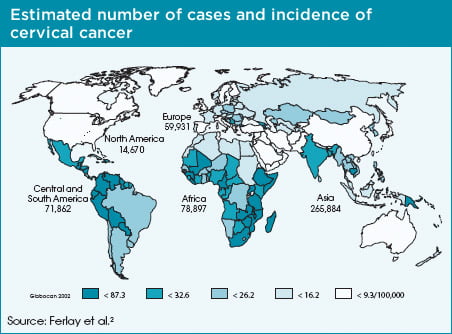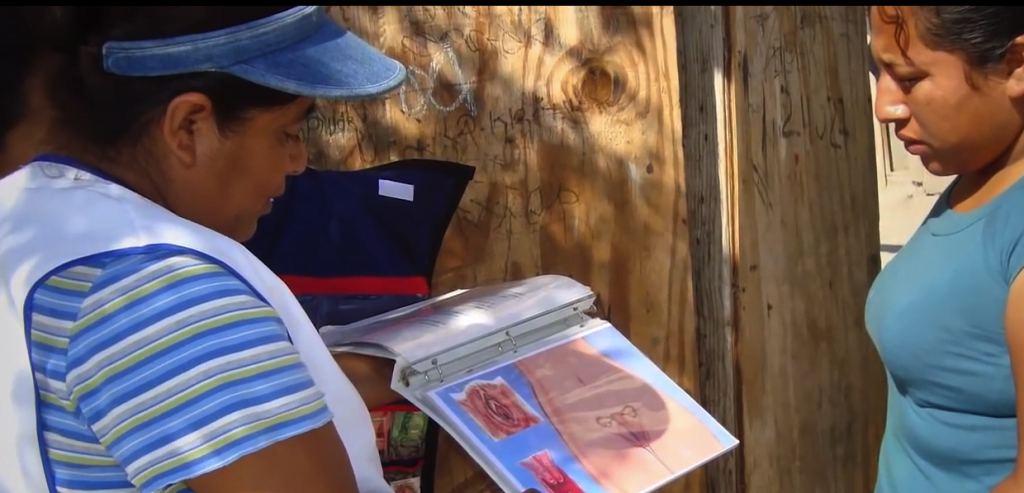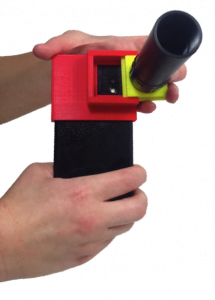By Michael Lefkoe, NoCamels
In 95 percent of cases, cervical cancer is an entirely treatable disease and can be treated for $28 in less than 40 minutes. Yet, due to lack of access to physicians and reliable medical equipment, hundreds of thousands of women in low-resource settings are dying unnecessarily every year simply because they are not getting diagnosed in time. However, one Israeli startup seems to be well on its way to changing that.
Five billion people have a phone, but no access to medical care
Recently featured on ‘Forbes’ list of 25 Hot Israeli Tech Startups To Watch, MobileOCT is trying to address the fact that while five billion people around the world have access to mobile phones, many of them do not have access to a physician. The company’s first project is to take on cervical cancer, the number one cause of cancer deaths for women in low-resource countries. To do so, they are producing a mobile colposcope that can be used with any mobile phone, anywhere in the world. “Technologically we’ve gotten to a place where we have very advanced sensors in everyday objects. And what MobileOCT is seeking to do is to help save lives with those sensors,” explained Ariel Beery, MobileOCT‘s CEO and Co-Founder, in an interview with NoCamels.
Sniffing out lung cancer is as easy as taking a breathalyzer test
Typical colposcopes used by Western physicians cost between $5,000 and $14,000, a price range that is undoubtedly out of reach for the 3.2 billion people who live on less than $3 of income per day. Clinically tested mobile colposcopies of comparable imaging quality produced by MobileOCT, on the other hand, will likely sell at the $400 price point, according to Beery. But diminishing the cost is only one of the ways that MobileOCT is impacting the future of cancer screening.
A perfect case study in global inequality
In the developed world, women between the ages of 21 and 65 are regularly screened for cervical cancer using what is known as the Pap test, and if any sort of abnormalities are found, the Pap test may be followed by a colposcopy (a medical diagnostic procedure to examine an illuminated, magnified view of the cervix) as well as a biopsy to determine whether or not she has cervical cancer. However, in low-resource settings these expensive diagnostic procedures are nowhere to be found.
“The problem is that for over two billion women around the world the only way they’re able to diagnose cervical cancer is with the naked eye,” Beery explained. The low-cost procedure Beery is referencing is known as Visual Inspection with Acetic Acid (VIA), or naked eye analysis, which has very low accuracy, only 17 percent according to Beery. Despite this dismal success rate, naked eye inspection continues to be used widely in the developing world because it is the only affordable option.
This is added to the fact that pain can often result from the screening method for women in low-resource settings. “Five out of six women who are diagnosed positive are misdiagnosed,” noted Stephanie Brill, an engineering student at the University of Southern California and one of MobileOCT’s nine dedicated interns. Brill and the rest of MobileOCT’s staff hope that the mobile colposcopy they have been developing will begin to dramatically change that statistic.
Once fully developed, the devices will be sold to community health workers in developing countries currently screening for cervical cancer using VIA. All they need to do is attach the device to their mobile phone, follow the instructions given in MobileOCT’s app, and upload the captured data and images to a secured server. That information is then made available to a screening physician who can provide close and continued instruction to the clinician as well as create a patient file to track progress.
In the developed world, women between the ages of 21 and 65 are regularly screened for cervical cancer using what is known as the Pap test, and if any sort of abnormalities are found, the Pap test may be followed by a colposcopy (a medical diagnostic procedure to examine an illuminated, magnified view of the cervix) as well as a biopsy to determine whether or not she has cervical cancer. However, in low-resource settings these expensive diagnostic procedures are nowhere to be found.
“The problem is that for over two billion women around the world the only way they’re able to diagnose cervical cancer is with the naked eye,” Beery explained. The low-cost procedure Beery is referencing is known as Visual Inspection with Acetic Acid (VIA), or naked eye analysis, which has very low accuracy, only 17 percent according to Beery. Despite this dismal success rate, naked eye inspection continues to be used widely in the developing world because it is the only affordable option.
This is added to the fact that pain can often result from the screening method for women in low-resource settings. “Five out of six women who are diagnosed positive are misdiagnosed,” noted Stephanie Brill, an engineering student at the University of Southern California and one of MobileOCT’s nine dedicated interns. Brill and the rest of MobileOCT’s staff hope that the mobile colposcopy they have been developing will begin to dramatically change that statistic.
Once fully developed, the devices will be sold to community health workers in developing countries currently screening for cervical cancer using VIA. All they need to do is attach the device to their mobile phone, follow the instructions given in MobileOCT’s app, and upload the captured data and images to a secured server. That information is then made available to a screening physician who can provide close and continued instruction to the clinician as well as create a patient file to track progress.
Building an affordable, high-quality colposcopy for the mobile phone
The “brains” behind the operation, co-founder Dr. David Levitz, PhD, is the CTO of MobileOCT and deserves much of the credit for the device’s early research and development. While at Tel Aviv University for his post-doctoral fellowship, Levitz sought to develop a multimodal imaging probe that combines infrared thermography and optical coherence tomography (OCT), hence where MobileOCT got its name.
The first version of the mobile colposcopy, which MobileOCT claims will be ready to sell in the coming months, would nearly triple the accuracy of cervical cancer detection from 17 percent (with VIA) to 45 percent. However, as Beery points out, “a woman in the developed world goes back for a biopsy (the removal of tissue to determine the presence or extent of the cancer), and that enables a gynecologist to know whether or not to operate, but a woman in the developing world does not have that opportunity.”
Israeli entrepreneurs reach out to the developing world in amazing ways
Since biopsies are too expensive for most women in low-resource settings, MobileOCT has plans to offer
another more sophisticated mobile colposcope in the future that is multimodal, meaning that the device would have several imaging modalities for looking at tissue. Thus, in addition to the Bright-Field Imaging used in all colposcopes, MobileOCT intends to add two additional layers of imaging modalities: Potential Difference Imaging and Spectral Imaging. This more advanced version of the device would further increase diagnostic accuracy to 70 percent, and will be available in the next couple of years pending the successful completion of multiple clinical trials.
The “brains” behind the operation, co-founder Dr. David Levitz, PhD, is the CTO of MobileOCT and deserves much of the credit for the device’s early research and development. While at Tel Aviv University for his post-doctoral fellowship, Levitz sought to develop a multimodal imaging probe that combines infrared thermography and optical coherence tomography (OCT), hence where MobileOCT got its name.
The first version of the mobile colposcopy, which MobileOCT claims will be ready to sell in the coming months, would nearly triple the accuracy of cervical cancer detection from 17 percent (with VIA) to 45 percent. However, as Beery points out, “a woman in the developed world goes back for a biopsy (the removal of tissue to determine the presence or extent of the cancer), and that enables a gynecologist to know whether or not to operate, but a woman in the developing world does not have that opportunity.”
Israeli entrepreneurs reach out to the developing world in amazing ways
Since biopsies are too expensive for most women in low-resource settings, MobileOCT has plans to offer
another more sophisticated mobile colposcope in the future that is multimodal, meaning that the device would have several imaging modalities for looking at tissue. Thus, in addition to the Bright-Field Imaging used in all colposcopes, MobileOCT intends to add two additional layers of imaging modalities: Potential Difference Imaging and Spectral Imaging. This more advanced version of the device would further increase diagnostic accuracy to 70 percent, and will be available in the next couple of years pending the successful completion of multiple clinical trials.
Social awareness as the key to good business
MobileOCT currently has five pilot programs in five countries to examine the usability of the device. As of May, they have partnerships with several leading global health organizations such as Partners in Health, UPenn’s Botswana Group, Scripps Medical Center, and the Montefiore Medical Center. In January, the device was validated by Dr. Bruce Kahn at Scripps, and was shown to provide magnification and resolution of skin tissue that is comparable to typical colposcopes.
Since its founding in 2012, the company has managed to raise $225,000 from investors. They made headlines after coming in first place at the International Startup Festival in Tel Aviv this past December, where 100 startups had the opportunity to pitch their ideas to investors while riding an elevator up or down one of the Azrieli Towers. Although $225,000 may not seem like a lot of money when compared to the millions poured into high-potential tech startups, one must keep in mind that MobileOCT is a social venture, and their goal is to keep costs as low as possible.
For Beery, doing well for the world means good business. “We’re trying to do the right thing and at the same time provide significant value to our investors and to our team, and that’s more wholesome and world aware business.”
MobileOCT video clip
MobileOCT currently has five pilot programs in five countries to examine the usability of the device. As of May, they have partnerships with several leading global health organizations such as Partners in Health, UPenn’s Botswana Group, Scripps Medical Center, and the Montefiore Medical Center. In January, the device was validated by Dr. Bruce Kahn at Scripps, and was shown to provide magnification and resolution of skin tissue that is comparable to typical colposcopes.
Since its founding in 2012, the company has managed to raise $225,000 from investors. They made headlines after coming in first place at the International Startup Festival in Tel Aviv this past December, where 100 startups had the opportunity to pitch their ideas to investors while riding an elevator up or down one of the Azrieli Towers. Although $225,000 may not seem like a lot of money when compared to the millions poured into high-potential tech startups, one must keep in mind that MobileOCT is a social venture, and their goal is to keep costs as low as possible.
For Beery, doing well for the world means good business. “We’re trying to do the right thing and at the same time provide significant value to our investors and to our team, and that’s more wholesome and world aware business.”
MobileOCT video clip


